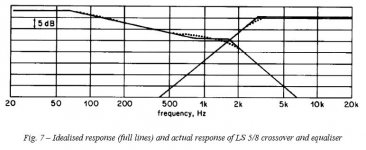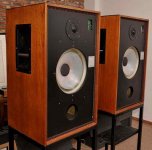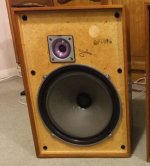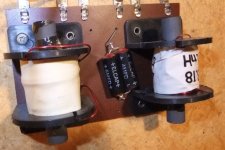Crossover (Network) schematic details for Rogers PM510 / Chartwell PM450 (LS 5/8)
Dear all,
I would be very interested to see details and a schematic of the passive crossover network used in the Rogers (Chartwell) PM510 Loudspeaker which is the domestic version of the Rogers (BBC) LS 5/8 grade 1 monitor.
I would like to build a pair of crossover networks so that I can have the option of passive / active operation using a pair of LS 5/8 monitors, hopefully I will soon find a pair!!
More info here
Rogers Loudspeakers › LS5/8
Dear all,
I would be very interested to see details and a schematic of the passive crossover network used in the Rogers (Chartwell) PM510 Loudspeaker which is the domestic version of the Rogers (BBC) LS 5/8 grade 1 monitor.
I would like to build a pair of crossover networks so that I can have the option of passive / active operation using a pair of LS 5/8 monitors, hopefully I will soon find a pair!!
More info here
Rogers Loudspeakers › LS5/8
An externally hosted image should be here but it was not working when we last tested it.
Last edited:
Falcon Acoustics UK
Derek Hughes - Graham Audio
Maybe they can release some (of the vintage/old) info. Will only work with the vintage parts anyway, pristine/originals drivers, not with new versions different specs, so no fuss here. Maybe Falcon had those in the past, have no idea. Did you try? The PM510 has been sold in the past on ebay (uk studio auctions?), or the PM450p Chartwell version (if the same?!).
Volt Loudspeakers | Volt Loudspeakers join Graham Audio?s quest to bring a legend to life?.
Do you have any info on the 12" vintage woofer (parameters, curves, measurements, models)?!
Derek Hughes - Graham Audio
Maybe they can release some (of the vintage/old) info. Will only work with the vintage parts anyway, pristine/originals drivers, not with new versions different specs, so no fuss here. Maybe Falcon had those in the past, have no idea. Did you try? The PM510 has been sold in the past on ebay (uk studio auctions?), or the PM450p Chartwell version (if the same?!).
Volt Loudspeakers | Volt Loudspeakers join Graham Audio?s quest to bring a legend to life?.
Do you have any info on the 12" vintage woofer (parameters, curves, measurements, models)?!
These guys should know: Rogers Loudspeakers › LS5/8
There is also a link to a document BBC RD 1979/22 containing detailed info.
There is also a link to a document BBC RD 1979/22 containing detailed info.
Last edited:
Hi Maybe I can help I have a pair of Rogers PM510's
Any help would be great thanks
The BBC PDF has the filter slopes at least.
You should be able to get close to that with a sim of electrical response using a passive network on a similar 12" bass, here polypropylene. 2kHz crossover?
Start with 2mH and 10uF shunt. Maybe 6.8uF and 0.2mH on the tweeter and resistor to attenuate.
Downloads
Always a worry that the tweeter might not go loud enough on a passive equivalent. But I think that big Audax will be OK.
The BBC might have added a 7.5R and 10uF Zobel to the bass. A bass tank notch at around 2.5kHz might help too. Just can help with a cone resonance.
You should be able to get close to that with a sim of electrical response using a passive network on a similar 12" bass, here polypropylene. 2kHz crossover?
Start with 2mH and 10uF shunt. Maybe 6.8uF and 0.2mH on the tweeter and resistor to attenuate.
Downloads
Always a worry that the tweeter might not go loud enough on a passive equivalent. But I think that big Audax will be OK.
The BBC might have added a 7.5R and 10uF Zobel to the bass. A bass tank notch at around 2.5kHz might help too. Just can help with a cone resonance.
Attachments
Rogers LS 5/8 or the domestic version ?
Hi everyone -
I have 6 months ago acquired (allegedlyà) the real BBC Rogers LS 5/8, ex BBC. How can I be abslutely sure that they er not the domestic version of the same speaker ( PM 510 ) ? . I have with them the Quads BBC modified with the filters inside.
Any help welcome
Alexander
Hi everyone -
I have 6 months ago acquired (allegedlyà) the real BBC Rogers LS 5/8, ex BBC. How can I be abslutely sure that they er not the domestic version of the same speaker ( PM 510 ) ? . I have with them the Quads BBC modified with the filters inside.
Any help welcome
Alexander
Hi everyone -
I have 6 months ago acquired (allegedlyà) the real BBC Rogers LS 5/8, ex BBC. How can I be abslutely sure that they er not the domestic version of the same speaker ( PM 510 ) ? . I have with them the Quads BBC modified with the filters inside.
Any help welcome
Alexander
Could you post some pictures of them?
These old threads are slightly embarrassing IMO. I am so much better these days than back in the day. Mainly due to that BBC afficianado Mark Hennessey: Rogers Loudspeakers › LS5/9
How the old BBC monitors worked was they were designed to be listened to on-axis, because they sounded entirely different off-axis. TBH, a 10 or 12" bass is quite a difficult animal. It has little usable output above about 2 or 2.5kHz. The polycone (plastic) bass is smoother than most paper 10 or 12" woofers, but still quite hard. So you need a BIG tweeter that can dig deep on a crossover point this low. A 1.5" tweeter was indicated. Usually the Audax TWO34: TW034
Next you need to know that negative polarity was essential. And was often eased by setting the bass back on the baffle. What you then did was used a BW3 third-order filter. And impedance correction on the bass: mh-audio.nl - Home
A lot of these designs used fairly unknown early electronic filters. But based on the Rogers LS5/9, I think we could work out some good values for a passive crossover to get going. The mystery is often a thing called bafflestep. This bass response is a variable. TBH, I think you can forego bafflestep just by placing the cabinets near a wall. All much simpler that way.
This sort of idea has strengths. I used to own some 12" bass Wharfedale Melton 2's with a ludicrously simple 3 element crossover with a simple near 2mH coil on the bass. It's an inoffensive sound if pointed to your ears , if a bit weak on dispersion for people listening in the corners.
For sure if you have a go at this, I will help you make it work. But this is a big project, which may take a while to get to the right place. A really good speaker is about 6 months work.
How the old BBC monitors worked was they were designed to be listened to on-axis, because they sounded entirely different off-axis. TBH, a 10 or 12" bass is quite a difficult animal. It has little usable output above about 2 or 2.5kHz. The polycone (plastic) bass is smoother than most paper 10 or 12" woofers, but still quite hard. So you need a BIG tweeter that can dig deep on a crossover point this low. A 1.5" tweeter was indicated. Usually the Audax TWO34: TW034
Next you need to know that negative polarity was essential. And was often eased by setting the bass back on the baffle. What you then did was used a BW3 third-order filter. And impedance correction on the bass: mh-audio.nl - Home
A lot of these designs used fairly unknown early electronic filters. But based on the Rogers LS5/9, I think we could work out some good values for a passive crossover to get going. The mystery is often a thing called bafflestep. This bass response is a variable. TBH, I think you can forego bafflestep just by placing the cabinets near a wall. All much simpler that way.
This sort of idea has strengths. I used to own some 12" bass Wharfedale Melton 2's with a ludicrously simple 3 element crossover with a simple near 2mH coil on the bass. It's an inoffensive sound if pointed to your ears , if a bit weak on dispersion for people listening in the corners.
For sure if you have a go at this, I will help you make it work. But this is a big project, which may take a while to get to the right place. A really good speaker is about 6 months work.
Attachments
These old threads are slightly embarrassing IMO. I am so much better these days than back in the day. Mainly due to that BBC afficianado Mark Hennessey: Rogers Loudspeakers › LS5/9
How the old BBC monitors worked was they were designed to be listened to on-axis, because they sounded entirely different off-axis. TBH, a 10 or 12" bass is quite a difficult animal. It has little usable output above about 2 or 2.5kHz. The polycone (plastic) bass is smoother than most paper 10 or 12" woofers, but still quite hard. So you need a BIG tweeter that can dig deep on a crossover point this low. A 1.5" tweeter was indicated. Usually the Audax TWO34: TW034
Next you need to know that negative polarity was essential. And was often eased by setting the bass back on the baffle. What you then did was used a BW3 third-order filter. And impedance correction on the bass: mh-audio.nl - Home
A lot of these designs used fairly unknown early electronic filters. But based on the Rogers LS5/9, I think we could work out some good values for a passive crossover to get going. The mystery is often a thing called bafflestep. This bass response is a variable. TBH, I think you can forego bafflestep just by placing the cabinets near a wall. All much simpler that way.
This sort of idea has strengths. I used to own some 12" bass Wharfedale Melton 2's with a ludicrously simple 3 element crossover with a simple near 2mH coil on the bass. It's an inoffensive sound if pointed to your ears , if a bit weak on dispersion for people listening in the corners.
For sure if you have a go at this, I will help you make it work. But this is a big project, which may take a while to get to the right place. A really good speaker is about 6 months work.
Thanks Steve for much useful insight!!
I am a fan of big two way designs as you might have guessed.
I currently use Spendor SA3s which use a 12" Bextrene cone and also BBC LS5/1AEs which use a 15" Goodmans unit!! these both have crossovers around 1.7K
The Spendor uses the predecessor to the Audax TW034X0 and the LS5/1AE a pair of Celestion HF1300s with the lower one rolled off at 5 Khz.
Hence the interest in the LS5/8 which seem to be lower priced on the user market than the passive equivalents.
Maybe I should roll my own?
Hey Darkmatter.. did you get any further with this plan? I sent you a PM btw.
No I never got any further with this.
Graham produced a drop in outboard crossover for the LS5/8 as a replacement for the active amplifier / crossover modules.
- Status
- This old topic is closed. If you want to reopen this topic, contact a moderator using the "Report Post" button.
- Home
- Loudspeakers
- Multi-Way
- Crossover (Network) schematic details for Rogers / Chartwell PM510 (LS 5/8)



